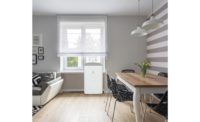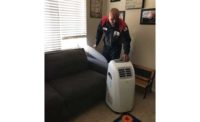Contractors are approaching a unique summer where the typical busy season will combine with a market that looks to be waning off a pandemic. Indoor air quality has certainly been a trend the past year, but one sector of the HVAC industry — portable cooling — has also seen kindled interest as a result of the prior year. Customers are thinking about their comfort in new ways, and portable cooling could represent a solution.
Trends in Portable Cooling

INTELLIGENT, PORTABLE TECH: ZoneAire portable air conditioners were integrated with smart technology in 2021, allowing voice control and connections with Amazon Alexa/Google Home. (Courtesy of Friedrich)
“Spot cooling unit design is evolving,” said George Doring, general manager, Spot Coolers. “Improvements are being made to create units that can better serve the portable and mobile nature of their operation.”
Portable cooling has seen a number of recent enhancements, including a general improvement in reliability, reduction in component failure, and quick connect features for air ducts and water fittings. In addition to this, smart technology is also making its way into portable air conditioners, allowing for improved controls, touch screens, and Wi-Fi capabilities. Friedrich’s ZoneAire portable air conditioners were integrated with smart technology in 2021, allowing voice control and connections with Amazon Alexa/Google Home.
“What used to be an add-on or an upgrade option, integrated Wi-Fi capabilities are now becoming increasingly standard for a wider array of a/c solutions,” said Brittany Calderon, product manager, Friedrich.
Indoor air quality trends have touched many different sectors of the HVAC marketplace, and portable cooling is not an exception. Michael Renier, vice president of sales at KwiKool, believes that improved IAQ capabilities will be increasingly incorporated into portable air conditioning. KwiKool’s BioKool products are offered with technologies such as HEPA filtering, UV-C lights, and needlepoint bipolar ion generators. In addition to this, a portable air conditioner’s dehumidification will help control a space’s moisture and reduce mold growth. This combines well with people’s growing interest in their health and the importance of their home’s air quality, temperature, and humidity in keeping occupants safe. Even outside the realm of staying free from disease, a suboptimal environment can affect sleep quality negatively.
“Careful examination of product specifications, features, and certifications is essential for validation of a product purchase,” said Renier. “For example, a HEPA-filtering claim must be tied to the proper thickness of the HEPA filter and the assignment of a valid certification, such as ETL, to meet these new requirements.”
People are becoming more conscious not only of their air quality but of their personal spaces as well. Those working at home are looking to make their offices more comfortable, and portable cooling offers a fix. More people have spent money on products relating to home improvement and outdoor hobbies, and Portacool’s director of product management and development, John Mays, said that portable air conditioners and evaporative cooler sales have benefitted from this.
“The additional time at home has also increased demand for contractors who provide services for home improvement and repair,” said Mays. “We do anticipate the industrial market to regenerate as companies return to normal operations over the next 12 months.”
Applications for Portable Cooling
A common but nonetheless crucial use of portable air conditioners is keeping customers cool during the busy season. This has become even more important as people spend more time in their homes because of the pandemic.
“Portable a/c’s can be a contractor’s best friend during a busy season,” said Calderon. “Keeping several units on hand to offer hot customers immediate relief allows contractors to keep up with a busy schedule while keeping customers cool and happy. It’s a real differentiator.”
Applications for the technology abound, including keeping contractors and technicians safe from the heat when working on job sites. Contractors utilize portable evaporative coolers in applications such as large plant shutdowns and residential construction. Portable products have also been used in the data center market when supplemental cooling is needed, and homeowners can use them for applications like home offices, garage conversions, and tiny houses.
“Evaporative cooling allows for energy efficient spot cooling in open-air environments,” said Mays. “Because portable evaporative coolers use a small amount of power, they can be run off of portable generators on the job site while being shared with other power tools.”
Portable cooling could help the transition back into offices as buildings reopen. The products with IAQ capabilities can help keep areas safe. And while some buildings are only operating at partial capacity, spot cooling can be used for the areas that require conditioning — without the need for cooling everything else.
“This way, repopulating buildings can be done with confidence and safety all at once,” said Doring. “Units can be quickly relocated as needed, offering comfort during various activities from office meetings to training sessions and more.”
The technology offers a simple solution to control a localized space. They can be moved around as needed and easily installed and controlled. They can also act as a short-term solution for larger scale needs when constricted by budgets or a repair schedule.
Portable Cooling For Customers
Contractors should take the time to understand their customers’ needs and portable cooling requests and make a solution recommendation based on that. Portacool’s Mays recommended that contractors not be too quick to only purchase evaporative coolers on price, but to examine price in tandem with other characteristics: performance, durability, warranty, evaporative media efficiency, and value. This will help contractors balance both their needs and their budget.
“Customers will motivate contractors to seek out better application solutions,” said Renier. “The contractors who contact portable manufacturers with customer requests and feedback will be better equipped to meet their customers’ needs.”








